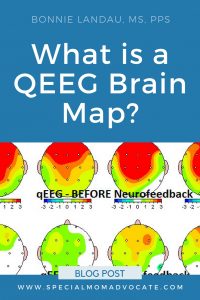 A QEEG (Quantitative Electroencephalogram) brain map is a way of measuring the electrical activity in the brain. This measure provides a clear picture of how the different areas of the brain are functioning. Very sophisticated statistical software is used to analyze the brain map and the information is then compared to norms for the age group. The result of this information can tell the clinician how the person’s brain is functioning, and if there are “problem” areas.
A QEEG (Quantitative Electroencephalogram) brain map is a way of measuring the electrical activity in the brain. This measure provides a clear picture of how the different areas of the brain are functioning. Very sophisticated statistical software is used to analyze the brain map and the information is then compared to norms for the age group. The result of this information can tell the clinician how the person’s brain is functioning, and if there are “problem” areas.
To do the brain map, the clinician puts a special cap on the patient’s head. The cap has electrodes that are then wired into a computer. The patient is then asked to do various activities, and the computer measures the brainwaves (see example). The activities could include looking at a single point while sitting still or closing the eyes and sitting very still.
How long does the process take?
It takes about 45 minutes to set up the cap and electrodes. The process of measuring brain activities takes about an hour after the cap is in place.
When my son did the brain map he did great through most of it. The last 10 minutes though he needed to sit stone still, and this proved to be a huge problem for him. He really had to move, even if it was only moving his finger.
I ended up coming in and doing grounding exercises to help keep him calm as he finished up. This helped a lot. I also had him sit in a hook-up, which I learned as a Brain Gym move for calming the mind and body. It was amazing to see how spiky his brainwaves were, then when he did the hookup they smoothed out right away. This proves this move is calming to the nervous system!
What does the brain map tell you?
Once the brain map was complete, the doctor sends it to a specialist to analyze and return a report. The report will show which areas of the brain are having difficulty. Once that is known, we can start the process of neurofeedback which will be focused on helping those areas that are not functioning well.
The brain map image above shows a QEEG brain map before and after neurofeedback. A healthy brain map should have a uniform green color to it. Areas that a red show the brain having overactive brainwave activity. Areas that a blue are underactive. Neurofeedback helps balance out brainwave activity so the brain calms down or speeds up, depending on what is needed.
ABOUT THE AUTHOR:
Bonnie Landau is a professional counselor and holistic therapist in Ventura County, California. Her specialities include therapy for autism, therapy for ADHD, and therapy for parenting who have kids with autism or ADHD or other neurodivergence. She changed careers from graphic design to counseling with the goal of helping struggling parents of kids with ADHD, autism, or other neurodivergence find strategies and solutions to help their children succeed. Bonnie is also the author of Special Ed Mom Survival Guide: How to Prevail in the Special Education Process and Find Life-long Strategies for You and Your Child.


